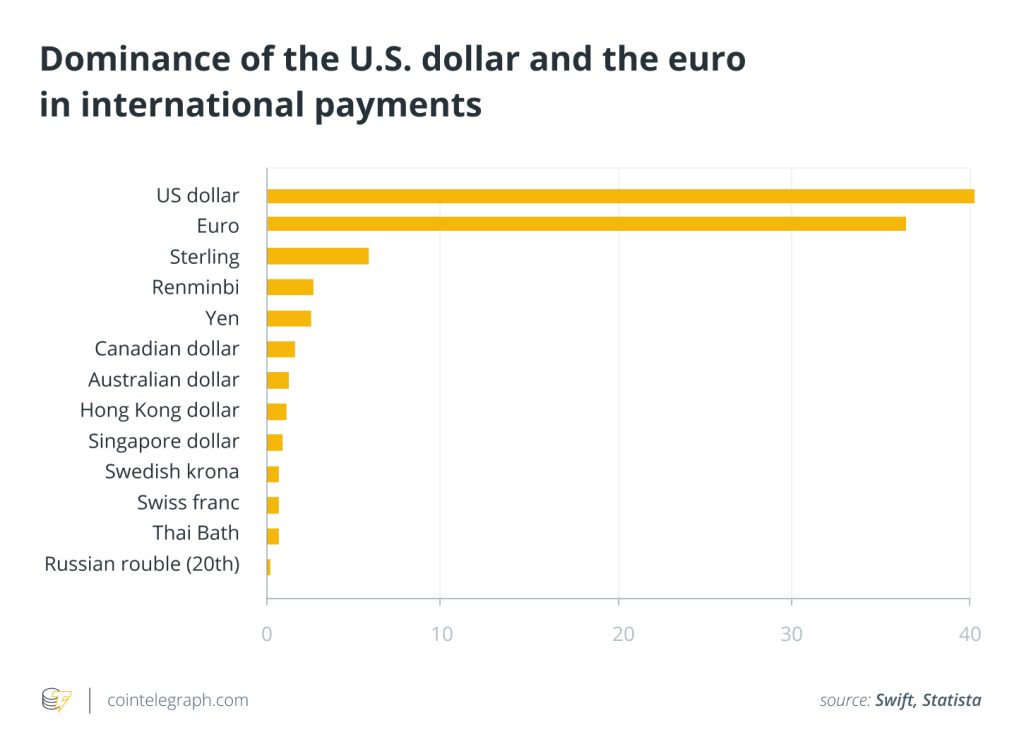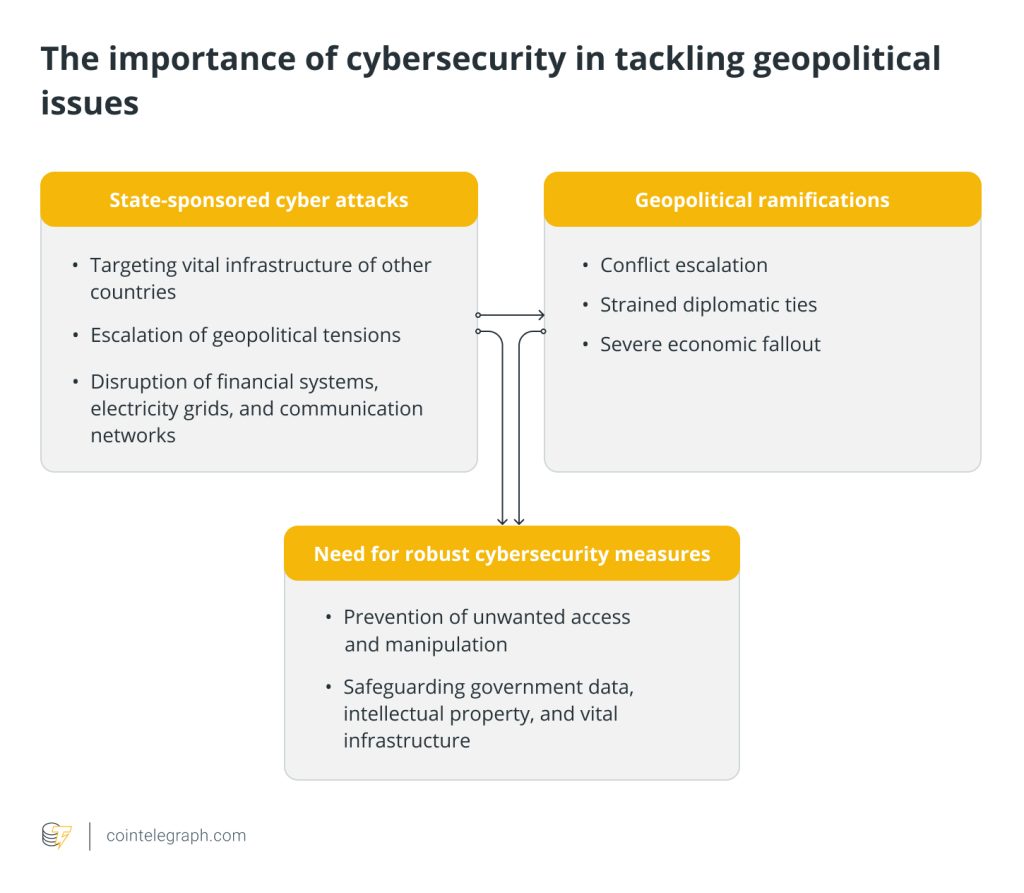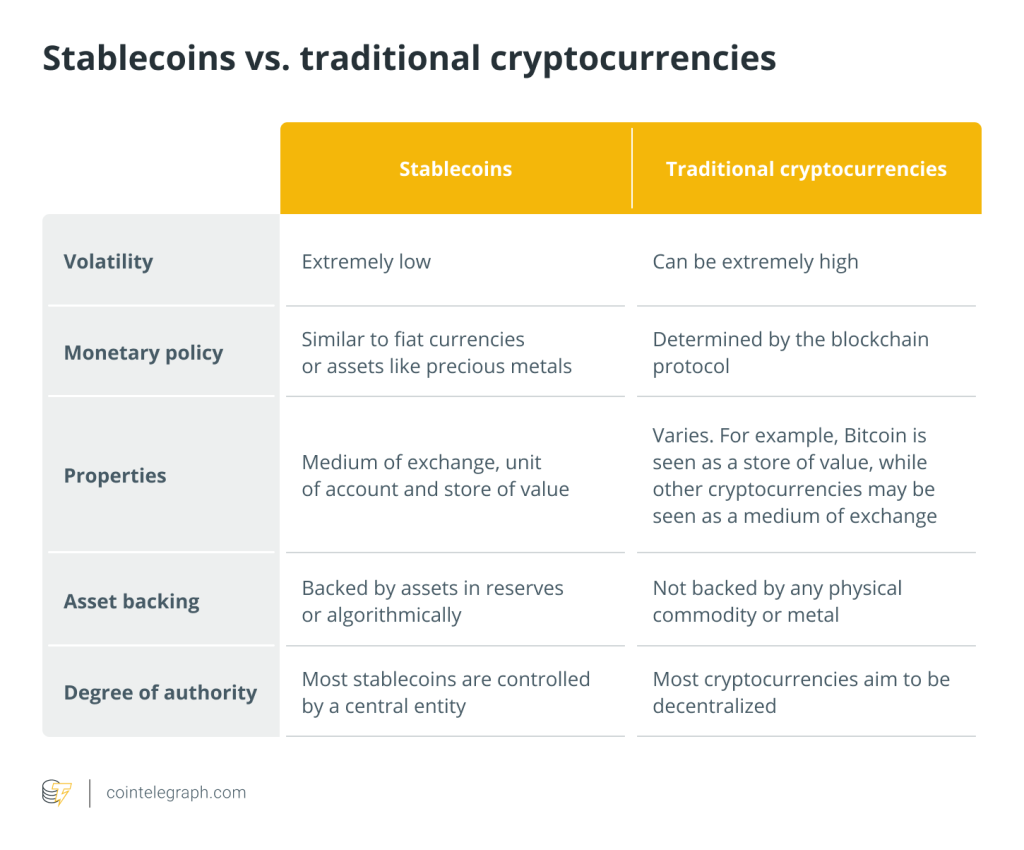The geopolitical significance of Bitcoin and fiat-pegged stablecoins


The global financial framework in place since the end of World War Two was established in 1944 during the Bretton Woods Conference. Among the decisions taken was that the United States dollar would be pegged to gold, and the currencies of other countries would be pegged to the U.S. dollar, establishing it as the world’s reserve currency.
In 2008, the reign of the dollar began to show indications of decline with the onset of the great financial crisis, which led to quantitative easing — a practice where central banks buy government bonds to stimulate the economy. One year later came the release of the then-obscure Bitcoin (BTC) — a revolutionary, open, borderless, permissionless, decentralized digital form of money.
The Chinese yuan has been gaining influence alongside China’s growing economy in recent years, while discussions intensify among Brazil, Russia, India, China and South Africa — known as the BRICS nations — about creating their own currency for international transactions, adding further pressure. These developments challenge the U.S. dollar’s long-standing hegemony and reflect a changing global environment and the desire for a more diversified monetary system.
Given that states like Texas, Florida and North Carolina have expressed skepticism about a U.S. central bank digital currency (CBDC), which is still in the research stages, the U.S. may struggle to find a solution to combat the dollar’s global economic decline. If states continue to oppose the rollout of a CBDC, the U.S. may have no choice but to abandon it and shift focus to alternatives like stablecoins.

But even if the U.S. does not abandon its CBDC research and aspirations, it will still have constraints. Although the U.S. dollar is legal tender in some countries and is used globally for international trade, it is not a universally accepted currency.
So far, there is no indication that a “digital dollar” will be available to non-U.S. citizens and regions for day-to-day transactions. The U.S. dollar is only legal tender in a few other countries with their own monetary problems, such as Ecuador, Zimbabwe, Micronesia, Palau, the Marshall Islands, El Salvador and East Timor. Stablecoins do not have these limitations.
The significance of stablecoins to the rest of the world
As geopolitical dynamics and international financial landscapes evolve, various stakeholders look to make their marks. The BRICS group, alongside Argentina and Brazil’s interest in a currency union for trade between the two countries, contributes to this changing environment. Simultaneously, discussions on a CBDC have sparked internal conflicts within certain U.S. states, such as Florida, North Carolina, and Texas.
To maintain its global financial leadership, the U.S. may explore alternative avenues and seize every opportunity available, including using fiat-backed stablecoins. The U.S. will likely strive to adapt to the shifting economic landscape while seeking to retain its prominent position in the global financial sphere.
The citizens of Brazil and Argentina use the U.S. dollar as a store of value to such a degree that both countries, in times of financial turmoil, restrict access to the dollar for the general population. A report from Argentina’s National Institute of Statistics and Census estimates that in 2022, Argentines held over $360 billion — more than 1.5 years’ worth of savings for the average citizen.
Stablecoins are similar to Bitcoin in that they are borderless, open and permissionless, allowing anyone to buy them. Stablecoins can be acquired by citizens through decentralized exchanges — in cases of hyperinflation or other instances of mismanagement of the economy — even if the government of Argentina does not want them to. One significant difference between Bitcoin and stablecoins is centralization.
This allows the company issuing the stablecoin to freeze holdings if ordered by the U.S. government. In 2022, USD Coin (USDC) issuer Circle froze over 75,000 USDC linked to 44 Tornado Cash addresses sanctioned by the U.S. Office of Foreign Assets Control’s Specially Designated Nationals and Blocked Persons list. Additionally, using blockchain analytics tools, governments can continue imposing sanctions if the holder is identified as a sanctioned state or person.
Therefore, the U.S. could use stablecoins to increase its U.S. dollar user base and liquidity in a potential confrontation with another currency. In fact, the U.S. does not need a currency confrontation to start whisking away users of other states into its system; it can begin immediately once the country recognizes the benefits.
Recognizing the potential threat of losing its financial sovereignty to the U.S., the European Union took proactive measures to safeguard its position. These measures included implementing capital controls, and capping the influence of foreign fiat and commodity-backed stablecoins, as outlined in the MiCA regulations.
Furthermore, the EU has exhibited a sense of urgency in developing its own CBDC — the digital euro — as a strategic move to maintain control over its financial system. These actions underscore the EU’s determination to protect its economic autonomy and reduce reliance on external factors that could compromise its financial independence.
For the EU, a CBDC bolsters the monetary sovereignty of the bloc, as the euro serves as a significant alternative to the U.S. dollar. By promoting the use of the euro in international trade and finance, Europe can reduce the potential for dollar stablecoins to take market share in the EU.
Europe can strengthen its geopolitical position by cooperating with other countries and regions. Collaborative efforts, such as establishing currency swap arrangements, expanding trade agreements and promoting financial cooperation with countries outside the U.S. dollar’s sphere of influence, can strengthen the euro’s position.

This can act as a remedy in case U.S. tech giants such as Meta, Amazon, Alphabet, Apple and Microsoft consider issuing their own U.S. dollar-backed stablecoins, which could further incentivize people to hold dollar stablecoins. Even if the stablecoins issued were commodity-backed, the central control would still be from a U.S. company and, by extension, the U.S. government.
Can other major countries use fiat-backed stablecoins to challenge the United States?
Other significant nations like China, Russia and India could employ the strategies mentioned above to increase their monetary and geopolitical influence and currency adoption through fiat-backed stablecoins under their control.
However, the market share of their currencies in the global market is much smaller than that of the dollar. Many people do not have favorable views on countries like China and Russia, so they will likely be skeptical about adopting their currencies.
Additionally, BRICS member countries would shoot themselves in the foot if they tried to influence each other’s citizens into adopting the fiat-backed stablecoins of other countries, abandoning their national currencies.
How does Bitcoin fit into the geopolitical and economic significance of stablecoins?
Countries engaging in currency wars using stablecoins can take one another hostage in terms of monetary policy, provided their citizens widely adopt the currency of the foreign government or company. However, amid the currency wars, there is one decentralized, borderless, censorship-resistant, peer-to-peer currency: Bitcoin.
While Bitcoin shares some similarities with stablecoins, it starkly contrasts them. Bitcoin runs on a decentralized network, which enables global economic participation in contrast to stablecoins under the control of central authorities. This decentralized nature ensures that no government or entity can exclude individuals or countries from engaging in transactions, making it a significant achievement for Bitcoin in promoting financial inclusivity and freedom.
Additionally, Bitcoin’s steady and limited supply will be a thorn in the side of countries engaging in currency wars — indirectly debasing citizens’ wealth and time — and prevent them from abusing their power or devaluing the currency too much for fear of the population switching to it instead.
Bitcoin faces challenges in market perception, with people like Warren Buffett calling Bitcoin a scam and saying it does not produce anything.
Despite Buffett’s acknowledged lack of technological expertise, he remains one of the most revered and influential investors globally. Given his stature as “The Oracle of Omaha,” his opinions continue to carry significant weight, even potentially impeding the mainstream adoption of certain technologies.
Besides Buffett, there are other obstacles to Bitcoin’s mainstream adoption, such as media coverage and economic illiteracy, which can be improved over time as Bitcoin continues appreciating in value and more people develop an interest in alternative stores of wealth.
The future of stablecoins and Bitcoin in the global geopolitical arena
As cryptocurrencies become more mainstream, there is a growing preference for stable and centralized currencies pegged to fiat currencies or commodities, especially in the short term. However, this trend may come with potential challenges.
To maintain or gain an advantageous position in the global economy, governments may resort to manipulation and power plays, incentivizing the adoption of national cryptocurrencies beyond borders.
This could lead to a loss of monetary independence for smaller and less economically stable countries. In engaging in currency wars and devaluing their currencies, these countries risk eroding the trust of their citizens and creating a scenario where a decentralized currency with limited supply emerges as an alternative they cannot control.






… [Trackback]
[…] Read More Info here to that Topic: x.superex.com/academys/beginner/3735/ […]
… [Trackback]
[…] Find More on that Topic: x.superex.com/academys/beginner/3735/ […]
… [Trackback]
[…] Find More on to that Topic: x.superex.com/academys/beginner/3735/ […]
… [Trackback]
[…] Info to that Topic: x.superex.com/academys/beginner/3735/ […]
… [Trackback]
[…] Info to that Topic: x.superex.com/academys/beginner/3735/ […]
… [Trackback]
[…] There you will find 72164 additional Information on that Topic: x.superex.com/academys/beginner/3735/ […]
… [Trackback]
[…] Read More on to that Topic: x.superex.com/academys/beginner/3735/ […]
… [Trackback]
[…] Read More on to that Topic: x.superex.com/academys/beginner/3735/ […]
… [Trackback]
[…] Information to that Topic: x.superex.com/academys/beginner/3735/ […]
… [Trackback]
[…] Read More on on that Topic: x.superex.com/academys/beginner/3735/ […]
… [Trackback]
[…] Here you will find 23629 more Information on that Topic: x.superex.com/academys/beginner/3735/ […]
… [Trackback]
[…] Find More to that Topic: x.superex.com/academys/beginner/3735/ […]
… [Trackback]
[…] There you will find 86510 additional Info on that Topic: x.superex.com/academys/beginner/3735/ […]
… [Trackback]
[…] Information on that Topic: x.superex.com/academys/beginner/3735/ […]
… [Trackback]
[…] Read More Info here to that Topic: x.superex.com/academys/beginner/3735/ […]
… [Trackback]
[…] Here you will find 94987 more Info on that Topic: x.superex.com/academys/beginner/3735/ […]
… [Trackback]
[…] Read More to that Topic: x.superex.com/academys/beginner/3735/ […]
… [Trackback]
[…] Information to that Topic: x.superex.com/academys/beginner/3735/ […]